The Rise and Fall of Grammar Bootcamp
Remember diagramming sentences? Remember reciting the state-of-being verbs, “am, is, are, was, were, be, being, been”? Humming “Conjunction Junction, what’s your function?”
These techniques may seem archaic, but the Common Core Learning Standards have prompted me to reexamine and retool how I teach grammar. I always have had some version of “Grammar Bootcamp,” usually at a point during the year when I have reached maximum patience with the fragments and run-on’s littering my students’ potentially excellent work.

The second group of 7th graders I teach later in the day came in deflated. The dreadful news about Grammar Bootcamp had already reached them. I’m used to this effect, but I press on because experience tells me that most push-backs are because students are not confident in their ability to succeed.
Does it really have to be self-contained?
You might fairly ask: “Why not just teach grammar in context in student writing?” Well, for one, I have 81 eighth graders and 56 seventh graders. And, due to wildly varying philosophies over the last 10 years, these students are arriving in my classroom with wildly varying amounts of grammar “time on task.”
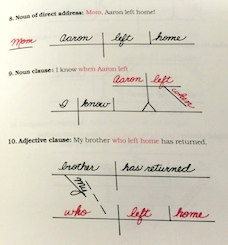
Yet I’d argue that it is much easier to improve students’ writing when I can say, “You need more adjectives.” Or, “If you combine that sentence with a FANBOY (the conjunctions: for, and, nor, but, or, yet, so) it will be much more sophisticated.” I’d rather frontload the grammar content so they can worry more about expression and less about where a comma goes.
But, that is not why I teach grammar explicitly. I teach grammar explicitly because “educated people” use correct grammar. That is not to say that slang, idioms, cultural proclivities, and accents don’t have a tremendous impact on language and communication – and create a rich lexicon.
My simple answer is this: grammatically correct language is the currency of higher education, so I feel it is my responsibility to show students both “what that looks like” via modeling, and also how to use it.
“But you’re a PBL kind of gal”
People who know my teaching – which emphasizes a project based, “Choose-Your-Own-Adventure” style of learning centered on student choice – don’t understand how “that Bootcamp of yours” fits in with the rest.
The short version is that it really doesn’t fit, and I am okay with that.
The longer version is that making grammar student centered is possible and desirable. Finding ways to have all students engaged at all times is, of course, the goal. But I’ll admit that (for me) doing so while teaching grammar is quite a challenge.
A brief history of Grammar Bootcamp
We always begin Bootcamp with a pre-assessment. This is meant to simply gauge students’ familiarity with the basics – nouns, verbs, adjectives, coordinating conjunctions, types of sentences, and sentence combining.
Some years, based on the data, I find that we can eliminate various topics. For example, last year nearly every student did well on the appositive section of the pre-assessment. Boggled, as this is not usually the case, I talked to the students who informed me that Mrs. Phillips, their 6th grade teacher, was a “fanatic” about them. I was happy to report to her that her teaching had “stuck.”
I keep the lessons brief and the opportunity for practice and participation high. I don’t assign homework (except some reading), so we do the work together, in pairs, and eventually independently.
After doing Bootcamp awhile, I stumbled upon my ace in the hole for teaching grammar: student-led review. I teach the mini-lesson, we practice together, they do questions with a partner, then they do some alone. Instead of me going over the answers, which is the tedious part that I think is most off-putting about teaching grammar, I have students lead the review. We have opportunities for productive struggle, but the class is there to help whenever a student isn’t sure.
What my student-parent survey revealed
As we finished the unit this year, I wanted to check in with students and parents to help me understand how to approach grammar next year.
Truth be told, it is complicated to grade writing when the foundations that various students bring are so different. It would be like grading an Algebra test knowing that a portion of the students had never learned subtraction, another group might not have learned how to use parentheses, and yet another group had never learned the distributive property.
I don’t want to bore students who know the material or overwhelm those who have a serious deficit and in the process turn everyone off to grammar.
I gave my students an anonymous survey about the unit and what I should do next year. Their answers were insightful and honest. The overwhelming majority believed that I should either do a daily warm-up with grammar or have a particular grammar day each week.
I was surprised that they were in favor of more grammar (with a few expected resounding NOs!), but what became apparent is that the concentrated Bootcamp style I’ve been using isn’t as effective as I believed.
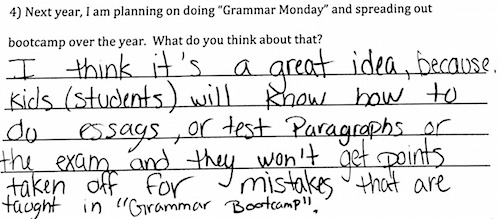
I also surveyed parents, and I had mixed comments and fewer participants than I would have liked (11/46 possible). But the comments I did get were telling. Essentially, parents wanted grammar to be interspersed with other instruction, just like their children.
The poll . . .
My summer of grammar
Like so many things about teaching, I learned something valuable when I asked those who are most likely to benefit – my students and their families.
I stand behind my decision to teach grammar in a direct and purposeful way. But I’m going to need to rethink how it is structured. Looks like I know what I’ll be doing this summer: planning my very own Grammar Reboot.
Amber Rain Chandler is a National Board Certified ELA teacher and education writer in Hamburg, NY. She leads professional development in Project-Based Learning, Danielson’s Domains, and Differentiation. Follow her on Twitter @MsAmberChandler and visit her website, AmberRainChandler.com.


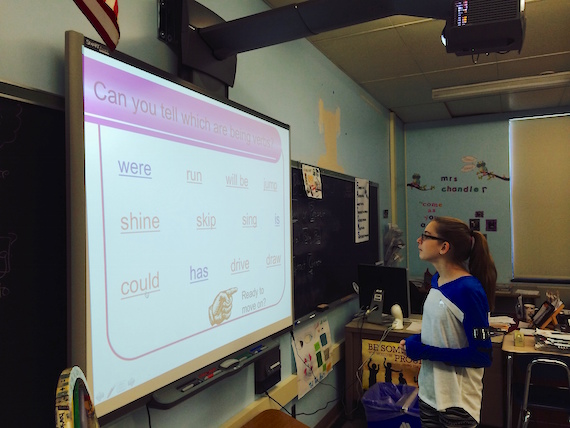
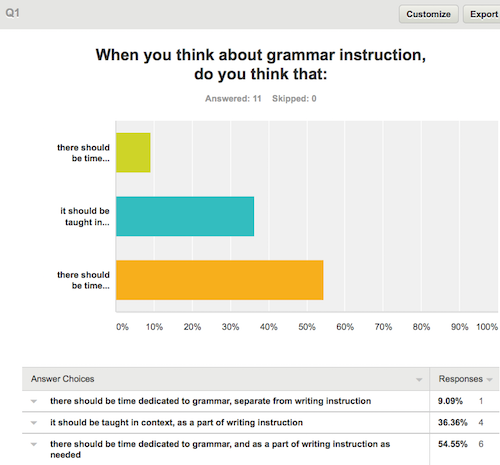
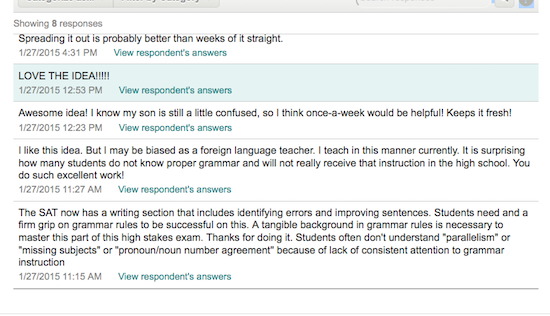

































This might be a great opportunity to incorporate flipped learning. Have the kids watch a video of you introducing a grammar component at home and report to class ready to demonstrate the skill.
Love everything about this. As a 6th grade English teacher, I wonder about the Monday Grammar days. Sometimes it’s hard to keep that up with the flow of other projects.
I like the video idea, this way we can work with the children at home to further instill what they have learned in class. This will be better because we will be in class with them, but at home.
With flipped learning if you see the student continually making the mistake they can go back and revisit the lesson. Also great for those students that are absent.
I start the year off with the Grammatical Order of Operations (GOO). We have steps that we use to figure out what each word in the sentence is. I start with a mini lesson on prepositional phrases, play games and learn songs to help with some memorizing, and then we locate them in sentences and put them in parentheses. We do this with each part of speech and then move to the harder “stuff!” I have found that this makes it stick much better and once we move on to other topics, such as clauses or using good versus well, they have the background knowledge of the parts of speech.
I agree the fundamental parts of speech must be assessed when a teacher gets new students. This is so important especially with the multi-lingual student population today!
I teach sixth grade. I introduce a mini lesson Mon. – Thurs. with sentences to edit nightly for HW. On Fri. selected students teach/explain the various lessons taught during the week to the entire class. They use their HW sentences to demonstrate these lessons. I add to these mini lessons frequently made mistakes in their current writing. I would like to try the filp class next year!
Thank you for this insightful article. I teach fifth grade in Memphis, Tenn., and am retooling my grammar instruction plans over the summer. I’m going to try DGP (Daily Grammar Practice) as well as incorporating explicit grammar instruction during writing time.